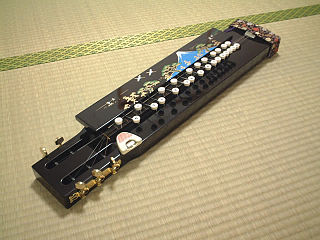Top Qs
Timeline
Chat
Perspective
Taishōgoto
Japanese musical instrument From Wikipedia, the free encyclopedia
Remove ads
The taishōgoto (大正琴), or Nagoya harp, is a Japanese stringed musical instrument. The name derives from the Taishō period (1912–1926) when the instrument first appeared. It is essentially a Keyboard Psalmodikon with multiple strings.
This article needs additional citations for verification. (April 2021) |

There are 4 types available: soprano has 5 or 6 strings, alto has 4 or 5 strings, tenor and bass have 1 or 2 strings.
The melody strings are tuned in G octave and the drone strings to D.[clarification needed]
Remove ads
History

The Taishōgoto was developed in 1912 by the musician Gorō Morita in Nagoya. He came up with the idea of combining the mechanics of a typewriter with an instrument.
The taishōgoto bears a close resemblance to the bulbul tarang from India, benju from Pakistan, the akkordolia from Germany, and Mandolin from Bali, Indonesia; all sharing the same principle of using keys to press down on strings to change their pitch. It also bears some resemblance to the Swedish nyckelharpa for the same reason, although the action and the method of playing the strings is very different. The instrument was used by Krautrock band Neu! on its first album in 1972, as well as by Harmonia.[1] The song "Big Ideas" by Arctic Monkeys features a taishōgoto solo.[citation needed]
Remove ads
References
External links
Wikiwand - on
Seamless Wikipedia browsing. On steroids.
Remove ads
